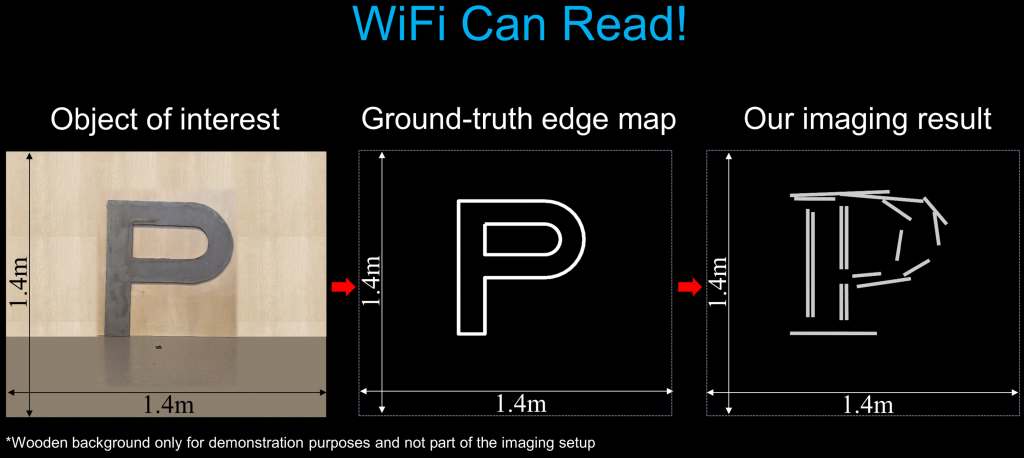Did you know that your Wi-Fi can "see" through walls?
Researchers in the lab of Professor Yasamin Mostofi at UC Santa Barbara have presented a new method that allows you to create high-quality images of still objects using WiFi signals. Based on the Geometric Theory of Diffraction, they use so-called Keller cones to track the contours of objects. This method allowed, for the first time, to read the English alphabet through walls using WiFi, which was previously considered a difficult task due to the detail of the letters.
"The image of static objects using WiFi is a significant challenge due to the lack of movement," said Mostofi, a professor of electrical and computer engineering. To solve this problem, the researchers focused on tracking the contours of objects.
Mostofi's research began back in 2009. Since then, they've been exploring the possibilities of using radio frequency signals like WiFi for a variety of applications, including crowd analytics, personal identification, smart health, and smart spaces.
"When a wave hits the edge of an object, a cone of outgoing rays is formed, which, depending on the orientation of the edge, leaves different traces on the receiver. We developed a mathematical model that uses these traces to determine the orientation of the edges, thus creating a map of the contours of the scene, " Mostofi continues.
The researchers also examined the effects of various parameters such as surface bending, edge orientation, receiver distance, and transmitter location on Keller cones and their proposed edge-based image system.
In the experiments, the team used three standard WiFi transmitters that sent radio waves to the area. WiFi receivers were installed on the driverless vehicle, emulating the receiving grid when driving.
Example of an image in conditions where the image does not pass through the wall: their method allows you to display details of the letter P in ways that were previously impossible.

Using this model, the researchers were able to recreate the contours of complex shapes, such as letters of the alphabet, reflected from Wi-Fi signals. However, it is worth noting that the Santa Barbara team does not claim that Wi-Fi can be used to read materials such as printed pages through solid walls.
Nevertheless, the discovery is of great practical significance. Identifying fixed objects can be useful in areas such as smart homes, structural monitoring, search and rescue, surveillance, and archaeological excavations.
Researchers in the lab of Professor Yasamin Mostofi at UC Santa Barbara have presented a new method that allows you to create high-quality images of still objects using WiFi signals. Based on the Geometric Theory of Diffraction, they use so-called Keller cones to track the contours of objects. This method allowed, for the first time, to read the English alphabet through walls using WiFi, which was previously considered a difficult task due to the detail of the letters.
"The image of static objects using WiFi is a significant challenge due to the lack of movement," said Mostofi, a professor of electrical and computer engineering. To solve this problem, the researchers focused on tracking the contours of objects.
Mostofi's research began back in 2009. Since then, they've been exploring the possibilities of using radio frequency signals like WiFi for a variety of applications, including crowd analytics, personal identification, smart health, and smart spaces.
"When a wave hits the edge of an object, a cone of outgoing rays is formed, which, depending on the orientation of the edge, leaves different traces on the receiver. We developed a mathematical model that uses these traces to determine the orientation of the edges, thus creating a map of the contours of the scene, " Mostofi continues.
The researchers also examined the effects of various parameters such as surface bending, edge orientation, receiver distance, and transmitter location on Keller cones and their proposed edge-based image system.
In the experiments, the team used three standard WiFi transmitters that sent radio waves to the area. WiFi receivers were installed on the driverless vehicle, emulating the receiving grid when driving.
Example of an image in conditions where the image does not pass through the wall: their method allows you to display details of the letter P in ways that were previously impossible.

Using this model, the researchers were able to recreate the contours of complex shapes, such as letters of the alphabet, reflected from Wi-Fi signals. However, it is worth noting that the Santa Barbara team does not claim that Wi-Fi can be used to read materials such as printed pages through solid walls.
Nevertheless, the discovery is of great practical significance. Identifying fixed objects can be useful in areas such as smart homes, structural monitoring, search and rescue, surveillance, and archaeological excavations.
